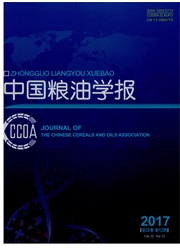

 中文摘要:
中文摘要:
以小鼠黑色素瘤细胞(B16)为抗肿瘤模型,通过MTT比色法评价米糠多糖及硫酸酯化米糠多糖对B16增殖抑制能力。以小鼠巨噬细胞Raw264.7细胞系为免疫模型,通过MTT比色法评价Raw264.7增殖能力,中性红吞噬试验评价巨噬细胞活性,Griess方法检测一氧化氮(NO)释放量,以及酶联免疫(ELISA)检测肿瘤坏死因子(TNF-α)分泌量,考察米糠多糖及硫酸酯化米糠多糖的免疫活性。研究发现:米糠粗多糖(RBP)和米糠多糖纯化组分(RBP2a)主要通过增强机体的免疫功能而间接抑制肿瘤细胞。质量浓度为250μg/m L时,RBP和RBP2a样品组的NO释放量分别为对照组的4.67、6.36倍,TNF-α分泌量为对照组的441.1、465.5倍;RBP直接组和间接组的B16抑制率分别为8.16%、45.55%,间接组的B16抑制率比直接组增长458%。硫酸酯化米糠多糖(SRBP-B,SRBP-D,SRBP2a-B)一方面可以直接抑制B16增殖,质量浓度为1 000μg/m L时,对B16抑制率达73.65%、65.53%、78.43%,另一方面也可通过免疫途径提高NO和TNF-α等细胞因子释放,进一步提高抗肿瘤活性。但高浓度SRBP-B,SRBP-D,SRBP2a-B能抑制Raw264.7增殖,在500μg/m L时,Raw264.7存活率仅为83.26%、81.8%、79.78%。
 英文摘要:
英文摘要:
Anti- tumor activity of rice bran polysaccharides( RBP and RBP2a) and sulfated polysaccharides( SRBP- B,SRBP- D and SRBP2a- B) on the mouse melanoma cells( B16) has been evaluated by MTT method in the paper. In addition,the proliferation activity,stimulation activity on phagocytosis,NO and tumor necrosis factor- α( TNF- α) production of Raw264. 7 cells have been also studied by MTT Method,Neutral Red Method,Griess Reaction and Enzyme- Linked Immunosorbent Method( ELISA). The results indicated that RBP and RBP2 a could increase anti- tumor effect through the host mediated pathway. Compared with the control group,RBP and RBP2 a significantly enhanced the release of NO( 4. 67 times and 6. 36 times) and TNF- α( 441. 1 times and465. 5 times) at 250 μg / m L. Therefore,immune- mediated inhibition rate( 45. 55%) on B16 was 4. 58 times higher than the direct inhibition rate( 8. 16%) at 250 μg / m L of RBP. Further,sulfated polysaccharide( SRBP- B,SRBP- D and SRBP2a- B) enhanced the anti- tumor activity by directly inhibiting B16. Sulfated polysaccharide( SRBP- B,SRBP- D and SRBP2a- B) could inhibit B16 proliferation while exhibit remarkably tumor- inhibitory rates( 73. 65%,65. 53% and 82. 43%) at 1 000 μg / m L. Meanwhile,SRBP- B,SRBP- D and SRBP2a- B significantly enhanced the release of NO and TNF- α. However,nonetheless,Raw 264. 7 cells were inhibited and revealed relatively lower survival rates( 83. 26%,81. 80% and 79. 78 %) at 500 μg / m L.
 同期刊论文项目
同期刊论文项目
 同项目期刊论文
同项目期刊论文
 期刊信息
期刊信息
